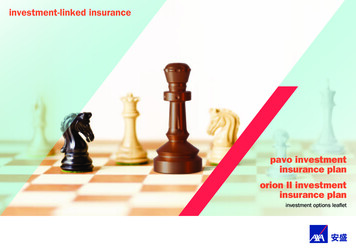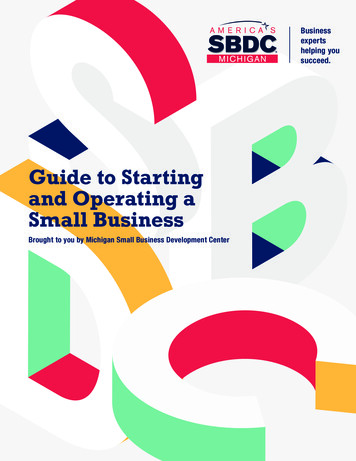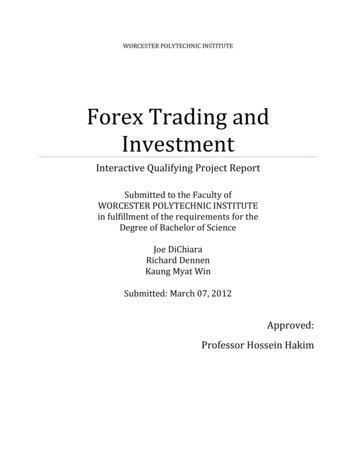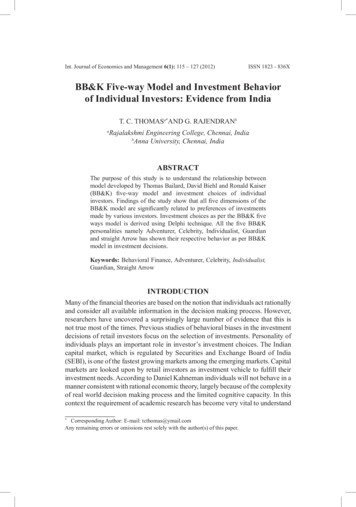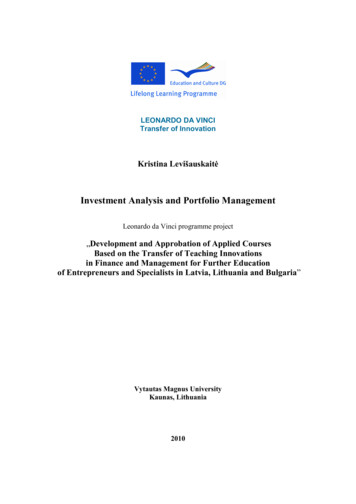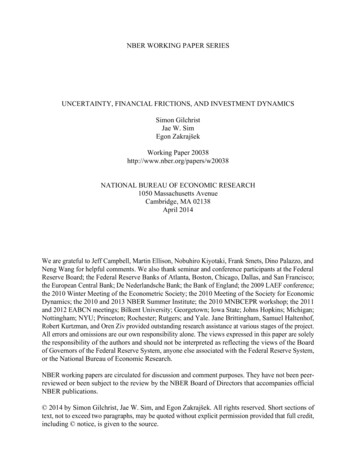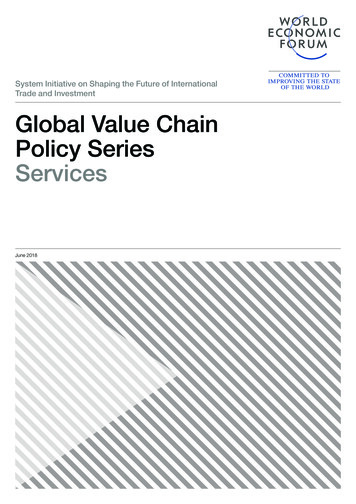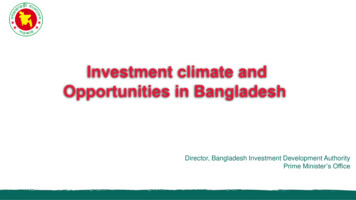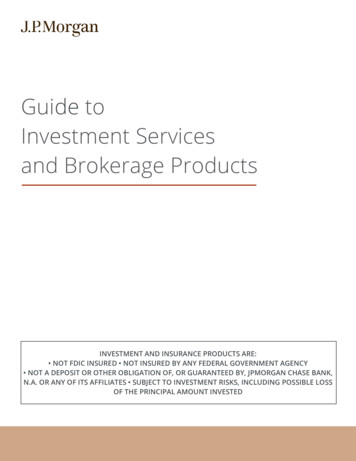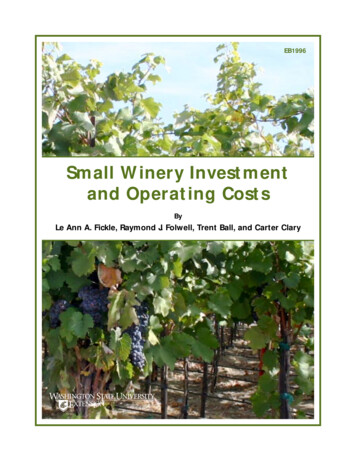
Transcription
EB1996Small Winery Investmentand Operating CostsByLe Ann A. Fickle, Raymond J. Folwell, Trent Ball, and Carter Clary
ABSTRACTTotal investment costs for the wineries in this study ranged from 560,894 for the2,000 case winery to 2,339,108 for the 20,000 case winery. Building and land costsaccount for the largest percentage of total investment costs for all wineries. Cooperageaccounts for the second largest percentage of total investment cost.The highest percent of variable costs for each winery are packaging costs. Fulltime labor, cooperage, and purchasing of grapes are the next highest operating costs bypercentage. Depreciation of capital assets makes up the highest percentage of fixed costs.Economies of size exist at a decreasing rate among all of the wineries. That is, asthe output of the winery increases, the per unit costs of production decline. Average totalcosts per case decrease from 154.41 for the 2,000 case winery to 124.93 for the 20,000case winery.The wineries in this study all have the ability to produce positive cash flows byyear three, showing that all operating costs and debt obligations can be met. Results showthat all wineries have the ability to repay all debt obligations and to operate as selfsustaining entities.
IntroductionThe Washington wine industry has experienced rapid and diversified growth. Washington Statenow maintains the second largest premium table wine industry in the United States. Growth inthe Washington wine industry is expected to continue due to the growing recognition ofWashington wines as a high end, premium product. The number of wine grape acres plantedacross Washington State reflects the growth of the industry, along with the increase in number ofwineries and wine sales. Wine grape acreage increased from 4,440 prior to 1992 to an estimated27,000 in 2004. The number of wineries increased from 19 in 1982 to 368 in 2004.The objective of this study is to develop an accurate depiction of current investment costs ofconstructing, owning, and operating a winery in the state of Washington. Potential investors andlenders will find this study useful in evaluating the expected profitability, cash flows, andpotential risk associated with investing in a winery. The specific objectives include:1. Identify the personnel and capital assets required to construct and operate fivewineries of various sizes, ranging from 2,000 to 20,000 annual case production2. Calculate the total dollar investment required to construct each winery3. Estimate the annual operating costs for each winery4. Calculate the annual cash flow for each winery5. Calculate net present value (NPV), internal rate of return (IRR), equity payback, anddebt recovery for each size wineryProceduresAn economic-engineering approach was used to gather information on investment and operatingcosts for wineries with annual case production of 2, 5, 10, 15, and 20 thousand cases (one case is12 bottles of 750 ml capacity). The economic-engineering approach was used along withWashington winery survey data to develop a standard while avoiding the problem of variationamong existing wineries. This approach allowed the models to be developed with generalcharacteristics common to all the wineries, such as using only new equipment and standardaccounting systems. Existing wineries also differ with respect to several characteristicsincluding:1) Average yield of juice extracted from each ton of grapes2) Quality of wine to be produced3) Temperatures and length of time of the fermentation process4) Amount of time the wine is aged5) Degree of labor and capital intensity6) Bottling dates7) Marketing method8) Access to grapes1
These characteristics, along with many others, influence the capital requirements and totalinvestment and operating costs of a winery. Due to the numerous combinations of thesecharacteristics, a limited number of realistic assumptions about quality, production, andmarketing were made so that the investment analysis could be conducted. The product mix andmarketing costs were taken from survey of wineries in the state to reflect actual conditions in theindustry.Financial models were developed based upon several assumptions. These assumptions reflectcurrent Washington wine industry standards and characteristics. Due to the lack of historicalinformation and unpredictability of the United States wine industry, a purely empirical approachwas avoided due to the variation in the ages of the various existing wineries and the differingaccounting systems used in the industry. There were two, very general assumptions maderelating to each of the five wineries. The first assumption was the separation between the wineryand any vineyard operation. The second assumption was used to help define the type and qualityof wine produced by the wineries. Each winery was classified as a premium winery, meaningthat wines retail at or above 8 per bottle. The assumption of a premium winery influences manyaspects of the production processes, therefore impacting some of the capital assets required.The following subsections describe other assumptions that were made in addition to theassumptions above.BuildingsThe winery buildings were considered primarily production facilities, with two-thirds of thesquare footage dedicated to production and storage. The remainder of the facility served as retailand office space.The structure was built for operating/production efficiency rather than aesthetics. All of thewineries have 30-foot insulated metal external walls with steel framing, built on concrete slabs.Each building had cat walks, windows, and bay doors and were equipped with standard lighting,electrical, and plumbing facilities. Control of the temperature throughout the winery wasaccomplished through commercial glycol air handlers. Other areas, including offices, production,and retail spaces, were assumed to have a standard commercial climate HVAC system. Theestimated construction costs and square footage for each winery are reported in Appendix A.EquipmentComprehensive equipment lists were developed for each individual winery. The list wascompiled using information gathered from surveys taken of wineries of the respective sizes inWashington. The equipment lists include equipment prices plus shipping and installation costs.All equipment was assumed to have been purchased new due to the lack of information andstandardization for used equipment prices in the wine industry. A detailed list including type,capacity, quantity, price, and features of the equipment are included in the equipment inventoryin Appendix A.2
All grape presses were assumed to be membrane presses with sizes ranging from one to four tonspress capacity per hour. Crush capacity on average yielded 62.5 cases (150 gallons) or 750bottles of wine per ton of grapes crushed.General practices in the Washington wine industry include the minimal filtration of wines,especially red wines. Many of the wineries that do filter use a plate and frame filter, rather thanmultiple filters such as membrane, leaf, or lees filters.The wineries were assumed to use jacketed stainless steel tanks for fermentation and for storage.Another method for fermentation and storage that has gained increasing popularity in recentyears is the use of fermentation bins. Fermentation bins are stainless steel, square, open topfermenters that hold up to 350 gallons of must.Fermentation tanks range from 450 gallons to 2,500 gallons, while storage tanks range from 250gallons to 1,000 gallons. Each winery used fermentation bins; however, the bins were utilizedmore by the smallest wineries. Assumptions regarding tanks included the use of glycol to controlthe temperature of the tanks during fermentation. Fermentation was 7 days for red wines and 21days for white wines.Product MixProduct mix assumptions were gathered from current Washington winery trends and fromsurveying the typical boutique wineries in Washington. Current trends include the shift fromwhite to red wine varieties. Significant white wine production is dominant in larger wineries( 50,000 cases annually) with the capabilities of producing more types of wines. Smallerwineries tend to predominantly produce red wines (Table 1).TABLE 1: Wine Varieties Produced and Percent of Total Output by Winery Size 0CasesRedCabernet Total ardonnayRieslingTotal White3
Total Investment CostsTotal investment cost for all of the wineries ranged from 560,894 for the 2,000 case winery to 2,339,108 for the 20,000-case winery (Table 2). As the winery size increases, so does theinvestment cost. However, the investment costs increase at a decreasing rate. The largestdifference among winery sizes was between the 2,000 and the 5,000 case winery. Per caseinvestment costs for the 2,000 case winery were 280.45. The 5,000 case winery had investmentcosts of 162.01, a difference of 137.84 per case for the two wineries. The smallest differenceoccurred between the two largest wineries. The 15,000 case winery had a per case investmentcost of 121.52 while the 20,000 case winery had an investment cost of 116.96, a difference ofjust 4.56 per case.TABLE 2: Total Investment Costs by Equipment Category and Winery Size ( )Cost Category2,0005,000Winery Size (Cases)10,00015,00020,000ReceivingEquipment 58,023.75 91,319.75 106,932.25 122,025.00 136,900.00Cellar Equipment 16,623.25 16,827.85 17,067.85 23,612.85 24,117.85Material Handling 49,520.00 49,520.00 49,520.00 49,520.00 49,800.00RefrigerationSystem 28,918.57 47,978.04 80,676.86 112,100.29 160,248.32Fermentation &Storage 49,800.45 74,775.75 79,285.50 97,240.50 186,873.75Cooperage 51,944.00 129,800.00 259,700.00 389,400.00 519,200.00Tasting Room 3,675.95 3,843.95 4,011.95 4,107.95 4,203.95Plant & Office 302,388.00 396,007.00Total Investment 560,893.97 810,072.34 1,330,695.41 1,822,426.59 2,339,107.87 733,501.00 1,024,420.00 1,257,764.00Per Unit /Case 280.45 162.01 133.07 121.52 116.96 /Gallon 117.83 68.07 55.91 51.06 49.14 /750 ml 23.37 13.50 11.09 10.13 9.75Plant and office equipment represent the majority of a winery’s investment costs (Table 3).Investment costs for plant and office equipment range from 49 to 56 percent of total investment.The reason the plant and office investment cost is much higher than any other costs is because itincludes building and land costs.4
The second most significant investment cost is cooperage (wooden wine barrels). Cooperageinitial investment costs range from 9 to over 22 percent of investment cost for some wineries.Another relatively significant investment cost includes receiving equipment, which ranges from6 to over 11 percent of a winery’s total investment cost.TABLE 3: Percent of Total Investment Costs by Equipment Category and Winery Size (%)Cost CategoryReceiving Equipment2,000Winery Size 85Cellar Equipment2.962.081.281.301.03Material Handling8.836.113.722.722.13Refrigeration System5.165.926.066.156.85Fermentation 221.3722.20Tasting Room0.660.470.300.230.18Plant & Office53.9148.8955.1256.2153.77Operating and Fixed CostsVariable operating costs were separated into the following eight categories:1) Grapes2) Cooperage3) Packaging4) Bottling5) Taxes and fees (federal excise tax, Washington state excise tax, business and occupations tax,and Washington Wine Commission dues)6) Full- and part-time labor7) Marketing8) Utilities, office supplies, and miscellaneousFixed operating costs were separated into the following six categories:1) Insurance2) Property tax3) Maintenance4) Depreciation5) Loan interest expense6) Cost of equity5
Each category is discussed below.Grape PricesGrape prices were calculated using a three-year average by variety to reflect recent price levelsin the industry. The varietal average was also used to help represent the significant pricedifferences reflected in prices for the different varieties. For the years 2002-2004, the averageprice per ton in Washington of Chardonnay, Riesling, Merlot, Cabernet Sauvignon, and Syrahwas 788, 685, 1,011, 1,174, and 1,201, respectively.CooperageThe percentage of new barrels purchased each year varies by winery and individual wine makingpractices. It is assumed that each winery would purchase 75 percent of their barrels new each year,except for the first three years, when the wineries will purchase all new oak barrels. Therefore,initially, barrels were considered an investment cost. After the third year, barrels were considered afixed cost. With the cost of new French Oak barrels upwards of 800, many wineries, especiallysmaller wineries, use alternative methods. American Oak is commonly considered an alternative tothe classic French Oak. For the purpose of this study we assumed that half of the barrel requirementsare met with French Oak and half are American Oak.Packaging CostsPackaging costs, including bottles, labels, corks, capsules, and case box materials, were gatheredby surveying several suppliers. The lowest quote for the packaging products was used todetermine total packaging costs.BottlingMobile bottling services consist of a mobile semi-truck equipped with all the necessary bottlingequipment. Mobile bottling outfitters are available for all wineries to reserve during bottling. Theservice provides one experienced operator while the winery provides the rest of the labor. In yearone, bottling occurs only for the White Riesling that is not barrel aged. In the following years, allof the wine is bottled.Taxes and FeesInformation regarding taxes was gathered from a variety of sources, primarily the WashingtonDepartment of Licensing, the Washington State Liquor Control Board, and the Bureau ofAlcohol, Tobacco, Firearms, and Explosives. Licensing fees include the master licenseapplication fee and, for the
Cellar Equipment 2.96 2.08 1.28 1.30 1.03 Material Handling 8.83 6.11 3.72 2.72 2.13 Refrigeration System 5.16 5.92 6.06 6.15 6.85 Fermentation & Storage 8.88 9.23 5.96 5.34 7.99 Cooperage 9.26 16.02 19.52 21.37 22.20 Tasting Room 0.66 0.47 0.30 0.23 0.18 Plant & Office 53.91 48.89 55.12 56.21 53.77 Operating and Fixed Costs Variable operating costs were separated into the following eight .


